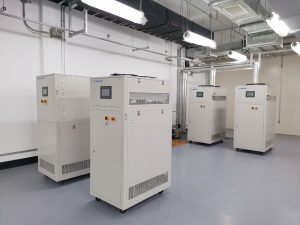Cómo funciona el sistema de enfriadoras de agua industriales?
When using industrial machinery, a cooling system may be required to prevent the machine from overheating. Refrigeration equipment can effectively keep materials in the optimal temperature range, but how does the chiller work? Understanding the working principle of industrial water chiller is very helpful to select the best refrigeration system to meet the needs of users.

Working principle of industrial water chiller
In short, industrial water chillers cool process fluids. Process fluid (usually water or water / glycol mixture) is used to cool machinery, equipment, etc. The process fluid absorbs heat from the cooled object and then passes through the chiller, where the heat is removed from the fluid and transferred to the ambient air.
Refrigeration circuit
The industrial water or glycol chiller system consists of two main circuits: refrigeration circuit and fluid circuit. The refrigeration circuit consists of four parts: compressor, condenser, expansion valve and evaporator. The refrigeration circuit removes heat from the process fluid. The fluid circuit usually consists of fluid reservoir, pump, filter and heat exchanger. The fluid circuit carries process fluid around the cooled object.
Refrigeration cycle steps:
Refrigeration circuit is the most technical part of the working mode of chiller. The refrigeration cycle uses the principle of thermodynamics to effectively transfer heat from one region to another. In the case of a chiller, heat is extracted from the cooled fluid and transferred to the ambient air.
Compresor
The refrigeration cycle starts with the compressor. The compressor uses gaseous low-pressure and low-temperature refrigerant to compress it into high-pressure and high-temperature gas.
Condensador
The gas then flows through the coils in the condenser. In the condenser, air or water will flow through the coil and remove heat from the refrigerant. As the refrigerant loses heat, it will begin to condense until all the gases condense into a liquid.
Válvula de expansión
After leaving the condenser, the liquid passes through the expansion valve. The expansion valve limits the flow of refrigerant. When the high-pressure liquid passes through the expansion valve, it enters the evaporator.
Evaporador
The evaporator is where the refrigerant begins to evaporate. When the refrigerant evaporates, it becomes very cold and absorbs a lot of heat. The process fluid will interact with the cold refrigerant in the evaporator. Heat is removed from the fluid and transferred to the refrigerant. The refrigerant then enters the compressor and the cycle begins again.
Recomendaciones relacionadas
-
Somos LNEYA, fabricante de enfriadoras
1923El fabricante de refrigeradores LNEYA se dedica a la I+D, la producción y la venta de sistemas de control de temperatura de refrigeración y calefacción, congeladores de temperatura ultrabaja, sistemas de prueba de componentes de automóviles de nueva energía y sistemas de ciclos de calefacción. Los ...
Ver detalles -
El proceso químico es inseparable del control de la temperatura
1314El proceso químico es inseparable del control de la temperatura
Ver detalles -
Cooling heating temperature control system SUNDI series thermal fluid filling instructions
19451. Refrigeration heating temperature control system SUNDI series equipment before the heat conduction filling, the heat transfer liquid inlet of the heating refrigeration circulator and the heat transfer liquid outlet of the upper end of the react...
Ver detalles -
You Should Know Something About Ultra Low Temperature Freezer
1294Ultra low temperature freezer is an indispensable cryogenic storage equipment in the field of life sciences and biopharmaceuticals. It can be used to store cells, tissues, test samples, vaccines, active enzymes, strains, plasmids, viruses, bacteri...
Ver detalles
 LNEYA Enfriadoras industriales Fabricante Proveedor
LNEYA Enfriadoras industriales Fabricante Proveedor












